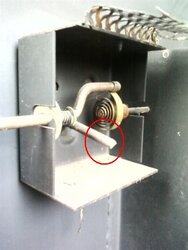Ok I'm at a total loss now. Out of desperation, I turned the hair dryer on the coil with the damper open 1/4", and it shut INSTANTLY. Opened it up another 1/4" and bang, same thing instantly again. Couple minutes later I checked, and the coil had cooled off and the damper was open again.
For those of you who haven't seen my other posts, I've had this whole mechanism apart and the damper "floats" on it's rod as if it's on ball bearings - VERY VERY easy to turn. Nothing is in a bind. The damper simply does not move on it's own when burning wood but turns effortlessly when I crank the rod down (after the temp climbs out of control). I have replaced a leaky door gasket which changed my problem from a wild up and down fluctuation to one that is stable for longer periods of time.
During a burn cycle, the coil refuses to do this and I have to mess with the damper by hand. WHY?!
Craig
For those of you who haven't seen my other posts, I've had this whole mechanism apart and the damper "floats" on it's rod as if it's on ball bearings - VERY VERY easy to turn. Nothing is in a bind. The damper simply does not move on it's own when burning wood but turns effortlessly when I crank the rod down (after the temp climbs out of control). I have replaced a leaky door gasket which changed my problem from a wild up and down fluctuation to one that is stable for longer periods of time.
During a burn cycle, the coil refuses to do this and I have to mess with the damper by hand. WHY?!
Craig


